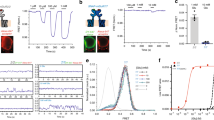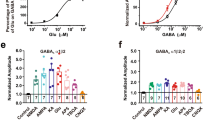Abstract
Transmitters mediating 'fast' synaptic processes in the vertebrate central nervous system are commonly placed in two separate categories that are believed to exhibit no interaction at the receptor level. The 'inhibitory transmitters' (such as glycine and GABA) are considered to act only on receptors mediating a chloride conductance increase, whereas 'excitatory transmitters' (such as L-glutamate) are considered to activate receptors mediating a cationic conductance increase1. The best known excitatory receptor is that specifically activated by N-methyl-D-aspartate (NMDA)2 which has recently been characterized at the single channel level3–5. The response activated by NMDA agonists is unique in that it exhibits a voltage-dependent Mg block3,6. We report here that this response exhibits another remarkable property: it is dramatically potentiated by glycine. This potentiation is not mediated by the inhibitory strychnine-sensitive glycine receptor7,8, and is detected at a glycine concentration as low as 10 nM. The potentiation can be observed in outside-out patches as an increase in the frequency of opening of the channels activated by NMDA agonists. Thus, in addition to its role as an inhibitory transmitter, glycine may facilitate excitatory transmission in the brain through an allosteric9 activation of the NMDA receptor.
This is a preview of subscription content, access via your institution
Access options
Subscribe to this journal
Receive 51 print issues and online access
$199.00 per year
only $3.90 per issue
Buy this article
- Purchase on Springer Link
- Instant access to full article PDF
Prices may be subject to local taxes which are calculated during checkout
Similar content being viewed by others
References
Iversen, L. L. Proc. R. Soc. B221, 245–260 (1984).
Watkins, J. C. & Evans, R. H. A. Rev. Pharmac. 21, 165–205 (1981).
Nowak, L., Bregestovski, P., Ascher, P., Herbet, A. & Prochiantz, A. Nature 307, 462–465 (1984).
Cull-Candy, S. G. & Usowicz, M. M. Nature 325, 525–528 (1987).
Jahr, C. E. & Stevens, C. F. Nature 325, 522–525 (1987).
Mayer, M. L., Westbrook, G. L. & Guthrie, P. B. Nature 309, 261–263 (1984).
Curtis, D. R., Hösli, L. & Johnston, G. A. R. Exp. Brain Res. 6, 1–18 (1968).
Graham, D., Pfeiffer, F., Simler, R. & Betz, H. Biochemistry 24, 990–994 (1985).
Monod, J., Wyman, J. & Changeux, J. P. J. molec. Biol. 12, 88–118 (1965).
Werman, R., Davidoff, R. A. & Aprison, M. H. Nature 214, 681–683 (1967).
Hamill, O. P., Bormann, J. & Sakmann, B. Nature 305, 805–807 (1983).
Kiskin, N. I., Krishtal, O. A. & Tsyndrenko, A. Ya. Neurosci. Lett. 63, 225–230 (1986).
Ferraro, T. N. & Hare, T. A. Brain Res. 338, 53–60 (1985).
Sigvardt, K. A., Grillner, S., Wallen, P. & Van Dongen, P. A. M. Brain Res. 336, 390–395 (1985).
Herrling, P. L., Morris, R. & Salt, T. E. J. Physiol., Lond. 339, 207–222 (1983).
Fagg, G. E. Trends Neurosci. 8, 207–210 (1985).
Nakajima, Y. J. comp. Neurol. 156, 375–402 (1974).
Choi, D. W., Farb, D. H. & Fischbach, G. D. Nature 269, 342–344 (1977).
Study, R. E. & Barker, J. L. Proc. natn. Acad. Sci. U.S.A. 78, 7180–7184 (1981).
Bormann, J. & Sakmann, B. IUPHAR 9th int. Congr. Pharmac. Abstr. S13–14 (Macmillan, London, 1984).
Haefely, W. E., Kyburz, E., Gerecke, M. & Möhler, H. Adv. Drug. Res. 14, 165–322 (1985).
Ransom, B. R., Neale, E., Henkart, M., Bullock, P. N. & Nelson, P. G. J. Neurophysiol. 40, 1132–1150 (1977).
Hamill, O. P., Marty, A., Neher, E., Sakmann, B. & Sigworth, F. J. Pflügers Arch. ges. Physiol. 391, 85–100 (1981).
Yellen, G. Nature 296, 357–359 (1982).
Johnson, J. & Ascher, P. Soc. Neurosci. Abstr. 12, 58 (1986).
Vyklicky, L. et al. Brain Res. 363, 148–151 (1986).
Ascher, P., Nowak, L. & Kehoe, J. S. in Ion channels in Neural Membranes (eds Ritchie, J. M., Keynes, R. D. & Bolis, L.) 283–295 (Liss, New York, 1986).
Nelson, P. G., Ransom, B. R., Henkart, M. & Bullock, P. N. J. Neurophysiol. 40, 1178–1187 (1977).
Author information
Authors and Affiliations
Rights and permissions
About this article
Cite this article
Johnson, J., Ascher, P. Glycine potentiates the NMDA response in cultured mouse brain neurons. Nature 325, 529–531 (1987). https://doi.org/10.1038/325529a0
Received:
Accepted:
Issue Date:
DOI: https://doi.org/10.1038/325529a0
This article is cited by
-
B-Glycine as a marker for β cell imaging and β cell mass evaluation
European Journal of Nuclear Medicine and Molecular Imaging (2024)
-
Inhibition of the NMDA Currents by Probenecid in Amygdaloid Kindling Epilepsy Model
Molecular Neurobiology (2024)
-
DNA methylation and the opposing NMDAR dysfunction in schizophrenia and major depression disorders: a converging model for the therapeutic effects of psychedelic compounds in the treatment of psychiatric illness
Molecular Psychiatry (2023)
-
STIM2 regulates NMDA receptor endocytosis that is induced by short-term NMDA receptor overactivation in cortical neurons
Cellular and Molecular Life Sciences (2023)
-
The NMDA receptor antagonists memantine and ketamine as anti-migraine agents
Naunyn-Schmiedeberg's Archives of Pharmacology (2023)
Comments
By submitting a comment you agree to abide by our Terms and Community Guidelines. If you find something abusive or that does not comply with our terms or guidelines please flag it as inappropriate.



